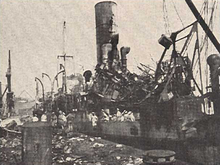Fort Stikine
|
The Fort Stikine
|
||||||||||||||||||||||
|
||||||||||||||||||||||
|
||||||||||||||||||||||
|
||||||||||||||||||||||
|
||||||||||||||||||||||
The Fort Stikine was a cargo steamer that exploded in the port of Bombay on the afternoon of April 14, 1944 , causing a major fire.
The ship
The Fort Stikine was built in 1942 by the Prince Rupert Drydock & Shipyard in Prince Rupert , British Columbia , and was named after a Hudson's Bay Company outpost in Wrangell , Alaska. The 7142 gross tonnage ship was a standard freighter of the North Sands type , the design of which was based on the Northeast Coast Open Shelterdeck Steamer of the British shipyard Joseph L. Thompson and Sons . The Fort Stikine was one of a group of 90 10,000-ton ships delivered between February 1942 and May 1943 that were built on the basis of the Hyde Park Declaration signed by Canada on April 20, 1941, and then acquired by the United States for the purpose of the To be used by Great Britain under the Lending and Lease Act during World War II .
Unlike the Liberty freighters , which were based on the same basic design from Great Britain, the North Sands ships stayed close to the original British plans. So they were mostly riveted . The propulsion system consisted of three coal-fired "Scotch" marine steam boilers, which supplied the steam required to operate a triple expansion engine designed by the North Eastern Marine Engineering Company and built at Dominion Engineering Works in Montréal.
The last trip
On February 24, 1944, the ship left Birkenhead for a voyage via Gibraltar and Port Said to Karachi and Bombay, which she reached on April 12, 1944. The ship's cargo consisted of explosives and ammunition, Supermarine Spitfire fighter planes , cotton balls, oil in barrels, wood, scrap iron and 124 12.73 kg bars of gold valued at the time between one and two million British pounds.
The explosion
After the mooring, Fort Stikine was in the harbor waiting for loading and unloading work to begin when a fire broke out in hold 2 on the afternoon of April 14, 1944. At around 2 p.m., the crew became aware of the fire and started fighting the fire together with the harbor fire brigade and fire boats. After around 900 tons of extinguishing water had been pumped into the ship without being able to contain the fire, the order to leave the ship was given at 15:50. Sixteen minutes later, the Fort Stikine exploded , breaking in two. The detonation shattered panes of glass within a radius of about twelve kilometers and was recorded by seismographs at the Colaba Observatory in the city. The area around the explosion site was set on fire within a radius of around 800 meters, and eleven ships in the port sank due to the explosion. Another explosion occurred at Fort Stikine at 4:34 p.m. during the first steps to combat the disaster that followed .
The fire in Bombay lasted three days and, according to official figures, killed 740 people and injured around 1,800 (unofficial estimates were far higher numbers). 27 ships were sunk or badly damaged in Victoria Dock and the neighboring Prince's Dock. After the fire was extinguished, it took around 8,000 emergency services seven months to clear around half a million tons of rubble. Until the 1970s, gold bars were repeatedly found in the port basin area in which the Fort Stikine exploded.
The Mumbai Fire Department erected a memorial at their headquarters to commemorate the "Bombay Explosion".
literature
- WH Mitchell, LA Sawyer: The Oceans, the Forts & the Parks . Volume two. Sea Breezes, Liverpool 1966.
Web links
- Report at atropedia (English)
- Report at merchantnavyofficers (English)
- Report at merchantships (English)
- Report at history.com (English)



